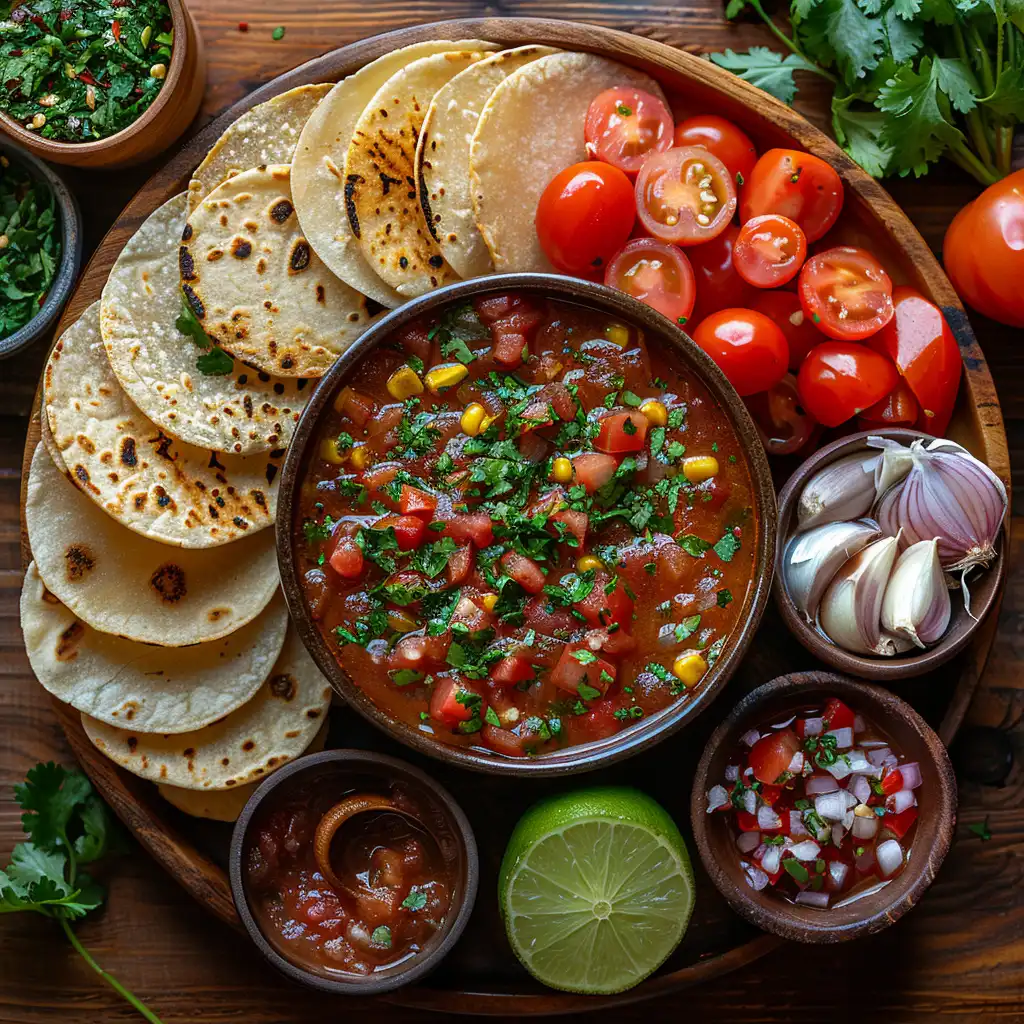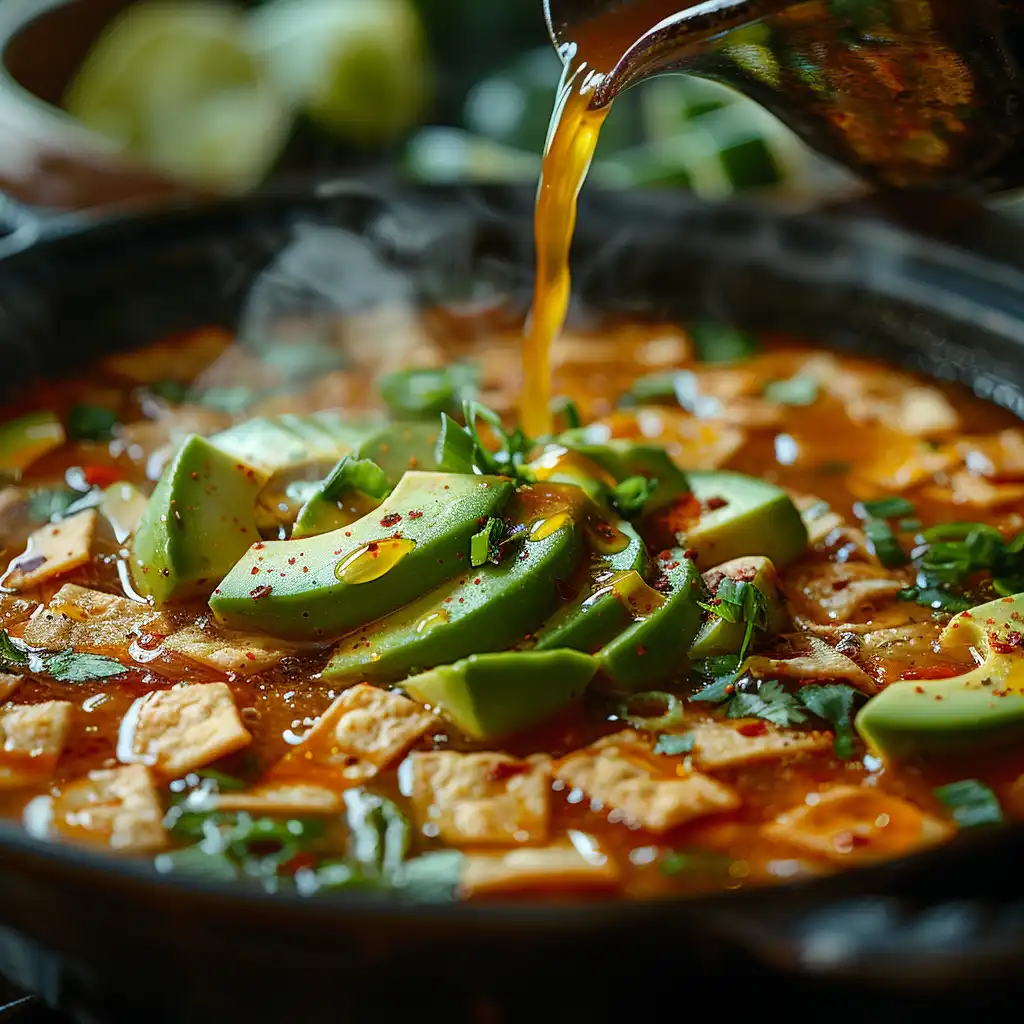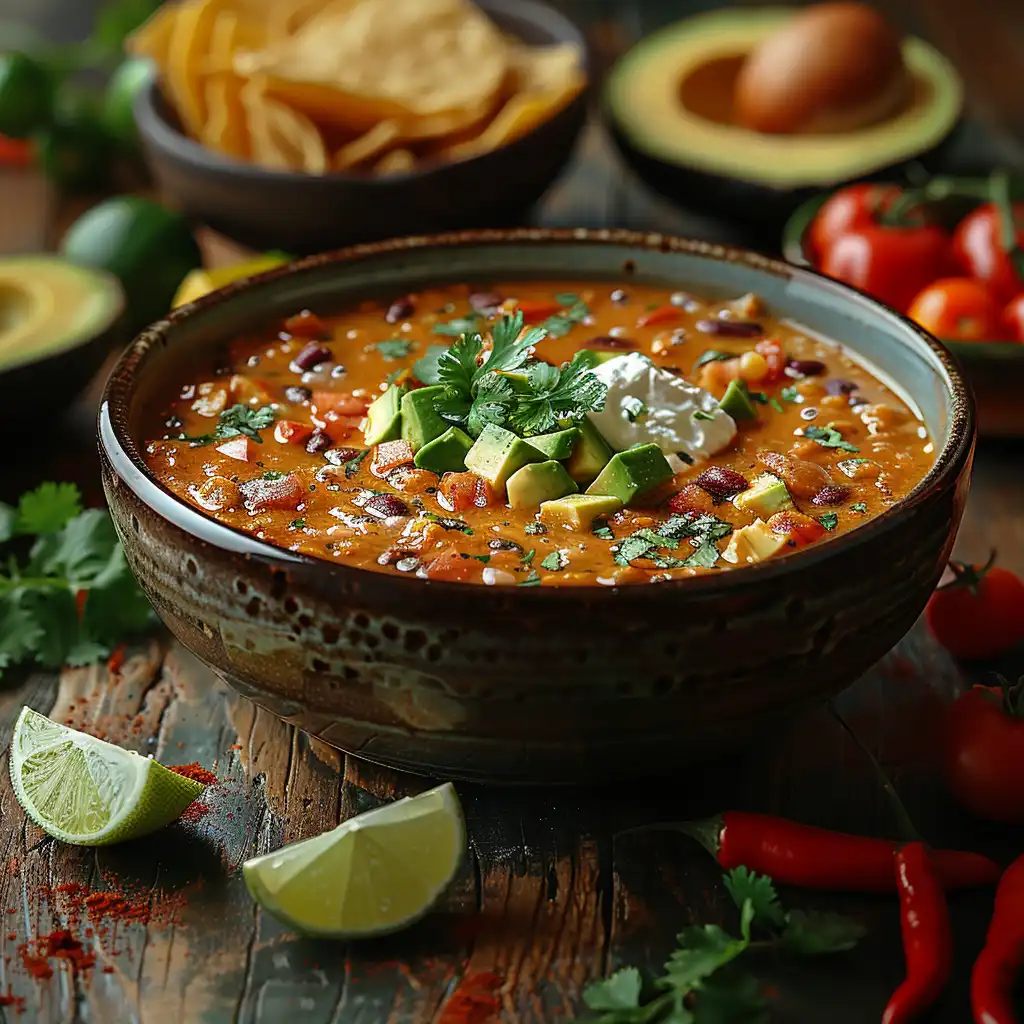Tortilla soup, or Sopa de Tortilla, is a culinary masterpiece deeply rooted in the cultural and historical tapestry of Mexico. This dish, renowned for its comforting flavors and vibrant ingredients, has captured the hearts (and taste buds) of people worldwide. In this article, we’ll delve into the fascinating history of Sopa de Tortilla, tracing its origins back to ancient civilizations, exploring how it evolved during colonial times, and understanding its cultural significance today. Whether you’re a food enthusiast or a history buff, this journey will leave you craving both knowledge and a warm bowl of this iconic soup.
Origins of Sopa de Tortilla
Pre-Columbian Roots of Sopa de Tortilla
Long before European explorers arrived, the people of ancient Mexico were already growing maize, or corn, with great skill. Maize was more than just food for them—it was a symbol of life and an important part of their culture. From maize, they made tortillas, which were a daily staple for civilizations like the Aztecs and Mayans. These early societies found creative ways to use tortillas in their meals, eventually creating what we now know as Sopa de Tortilla.
One key ingredient in this soup, chile pasilla, also has roots in these ancient times. Indigenous people loved chiles for their strong flavors and their healing properties. They used them to add spice and depth to their food. These simple yet powerful ingredients became the foundation for what would later evolve into a much-loved Mexican dish.
The Role of Tlaxcala in the Dish’s Creation
The state of Tlaxcala has an important connection to the history of Sopa de Tortilla. In Nahuatl, Tlaxcala means “the place where tortillas are plenty,” which makes sense because the region has always produced a lot of maize. Many believe this area played a key role in creating the dish.
People from Tlaxcala are said to have used leftover tortillas with simple soup ingredients like tomatoes, chiles, and water to make a practical and tasty meal. This clever idea turned a common food into a flexible and satisfying dish. Using tortillas as the main base for soups became an important part of the region’s cooking traditions.
The Aztec Influence on Sopa de Tortilla
The Aztecs, known for their rich culinary heritage, undoubtedly contributed to the development of Sopa de Tortilla. The dish’s communal nature aligns with the Aztec practice of gathering to share meals, emphasizing the importance of community and family.
Their use of dried tortillas in soups allowed for efficient storage and preparation, ensuring that food could be preserved and used in various ways. The Aztecs also incorporated ingredients like chile pasilla and epazote (a traditional herb), which continue to define the flavor profile of the dish today.
Colonial Influence on Sopa de Tortilla
Fusion of Spanish and Indigenous Cuisine
When the Spanish arrived in the 16th century, it changed Mexican food in many ways, and Sopa de Tortilla was part of this change. They brought new ingredients like cheese, cream, and garlic, which local people had never used before. These new ingredients worked well with native staples like tortillas, chilies, and tomatoes, creating a delicious mix of flavors. This blend of European soups and traditional tortilla-based recipes made Sopa de Tortilla into a more refined dish that could please many tastes.
The Spanish also learned from the cooking methods of the native people while introducing their own. This sharing of food traditions created a unique style of Mexican cooking, and Sopa de Tortilla is a great example of this cultural mix.
Development of Sopa Azteca
Over time, Sopa de Tortilla changed into what we now call Sopa Azteca. This version became especially popular in central Mexico, where the recipe was improved to include ingredients like chile pasilla and epazote. Adding crispy tortilla strips made the dish even better by giving it a crunchy texture that paired perfectly with the rich and spicy broth.
These changes were about more than just taste—they showed the creativity and resourcefulness of the Mexican people. Even with the influence of colonization, they kept the heart of their cooking alive, making Sopa Azteca a dish that still feels truly Mexican.
The Role of Chilies in Colonial Adaptations
Chilies, an important part of pre-Columbian cooking, stayed essential to the recipe even after colonization. During this time, spices like chile pasilla and chile de árbol were used in more creative ways. These chilies not only made the soup spicy but also gave the broth rich and smoky flavors.
Their flexibility made the dish appealing to many tastes, helping it stay popular over time. Chilies also became a symbol of cultural pride, reminding people of their heritage while adapting to new influences.
Regional Variations of Sopa de Tortilla
Popularity in Central Mexico
Central Mexico, especially the busy streets of Mexico City, is known as the heart of Sopa de Tortilla. Here, the soup is usually made with a rich chicken or vegetable broth and topped with simple yet tasty ingredients like avocado, sour cream, and grated cheese. Its colorful look and bold flavors make it popular in both family homes and fancy restaurants.
Local versions often use the fresh ingredients grown in the region. Some recipes add corn kernels, beans, or even nopal (cactus) to give extra texture and flavor. The dish’s versatility has made it a beloved comfort food for many generations.
Variations in Tlaxcala and Beyond
While central Mexico’s version remains iconic, other regions, such as Tlaxcala, put their unique spin on the dish. In Tlaxcala, the birthplace of tortillas, the soup often highlights simpler, rustic flavors. Locally grown herbs and freshly made tortillas are prioritized, resulting in a dish that feels both traditional and deeply connected to the land.
Further south, in Oaxaca, Sopa de Tortilla often incorporates smoky Oaxacan chilies and indigenous spices, creating a more intense and aromatic experience. This regional variation reflects the diversity of Mexican cuisine and its ability to adapt to local tastes.
Modern Regional Takes
Today, chefs across Mexico are trying new ways to make Sopa de Tortilla, using modern cooking methods and ingredients from around the world. For example, some fancy restaurants now serve the dish in a “deconstructed” style, pouring the hot broth over crispy tortilla strips and toppings right at the table. Others add new flavors, like chipotle cream or roasted red peppers, to give it an international twist.
No matter the changes, the heart of the dish—a warm and comforting bowl of tortilla soup—stays the same. It continues to show the creativity and flexibility of Mexican cooking.
- Relevant link for deeper exploration: Sopa de Tortilla Guide on TastyFables
- Recipe details for comparison: What Is Sopa de Tortilla Made Of?
By incorporating these internal links, readers can gain further insights into the history and preparation of this iconic dish. These connections provide additional context and enhance the overall user experience.
Ingredients and Preparation Through Time

Traditional Ingredients
At its heart, Sopa de Tortilla is all about simple, wholesome ingredients. The traditional recipe uses basics like corn tortillas, ripe tomatoes, chile pasilla, and garlic. These ingredients come together to make a rich, tasty broth with smoky and earthy flavors. Fried tortilla strips are often blended into the soup to make it thicker and give it a hearty texture.
Tomatoes are roasted or slightly burnt before blending to create a sweet yet tangy flavor. Chiles, especially chile pasilla, add the smoky and spicy taste that makes the soup unique.
Modern Additions to the Dish
Over time, Sopa de Tortilla has evolved, with modern recipes incorporating ingredients that elevate its taste and presentation. Creamy toppings like sour cream or crema Mexicana are often swirled into the broth, adding a luscious texture. Avocado slices bring freshness and balance, while grated cheese (usually queso fresco or cotija) adds a salty, tangy finish.
Some modern versions even experiment with protein, such as shredded chicken or beef, making the soup a more complete meal. Other chefs add roasted vegetables or beans, drawing inspiration from global cuisines while keeping the dish’s essence intact.
For a more in-depth look at the traditional and modern ingredients used in Sopa de Tortilla, check out What Is Sopa de Tortilla Made Of?.
The Cultural Importance of Sopa de Tortilla
A Dish of Community and Heritage
Sopa de Tortilla is more than just a dish—it’s a symbol of Mexican culture and community. In many households, it’s a staple served at family gatherings, reflecting the tradition of coming together over hearty, homemade food. The communal aspect of preparing the soup, from frying tortillas to blending the broth, fosters a sense of connection and shared heritage.
The dish is also deeply tied to Mexico’s agricultural history. Corn, tomatoes, and chiles—the soup’s primary ingredients—are cornerstone crops that have sustained the region for centuries. By enjoying Sopa de Tortilla, people are reminded of their roots and the resilience of their ancestors.
Global Recognition and Modern Legacy
In recent years, Sopa de Tortilla has gained global fame, appearing on menus at Mexican restaurants around the world. Its vibrant flavors and comforting qualities make it a favorite among food enthusiasts everywhere. The dish’s versatility also allows chefs to adapt it to local tastes without losing its essence, ensuring its relevance across cultures.
Despite its international popularity, Sopa de Tortilla remains a quintessentially Mexican dish, cherished for its ability to bridge the gap between past and present. It’s a culinary time capsule, preserving the flavors and traditions of pre-Columbian Mexico while embracing modern influences.
For more Mexican recipes that celebrate cultural heritage, explore Sopa de Tortilla Guide for tips and variations.
With its rich history and enduring appeal, Sopa de Tortilla continues to tell the story of Mexico’s culinary evolution. Whether you’re savoring a traditional bowl in Mexico or a modern adaptation abroad, the dish always delivers a taste of history and home.
Sopa de Tortilla in Modern Culinary Trends
Contemporary Adaptations of a Classic
Today, Sopa de Tortilla has taken on fresh, modern styles while still keeping its traditional charm. Many chefs now try creative versions of the dish, serving the crispy tortilla strips on the side and pouring the hot broth at the table for a more dramatic and fun experience. These changes aim to make the soup more interesting and visually appealing.
Some chefs also add global flavors to the recipe. For example, they use roasted red peppers or smoked paprika to give the broth a richer taste. Others swap out traditional Mexican crema with Greek yogurt for a lighter option. Even with these updates, the soup keeps its original spirit, showing how flexible it is.
Plant-based versions of the soup are also becoming popular. Instead of chicken stock, vegetable broth is used, and tofu or roasted chickpeas are added for protein. These new variations make Sopa de Tortilla easier for people around the world to enjoy, helping its tradition live on.
A Global Love for Sopa de Tortilla
As Mexican cuisine continues to grow in popularity worldwide, Sopa de Tortilla has emerged as a beloved ambassador of the country’s rich culinary heritage. Restaurants around the globe offer variations of the soup, catering to local palates while preserving its signature elements.
Its wide appeal lies in its ability to adapt without losing its authenticity. Whether enjoyed as street food in Mexico City or served at a high-end restaurant in New York, Sopa de Tortilla continues to capture the hearts of food lovers everywhere. It’s a dish that bridges cultures and showcases the timeless ingenuity of Mexican cooking.
FAQs and Popular Questions
What is the history of Sopa de Tortilla?
The origins of Sopa de Tortilla can be traced back to pre-Columbian Mexico, where indigenous peoples used maize, chilies, and tomatoes to create nourishing meals. Over time, the dish evolved during colonial Mexico, blending Spanish and indigenous culinary traditions. Today, it stands as a symbol of Mexican heritage and culinary creativity.
How does Sopa Azteca differ from Sopa de Tortilla?
Although the terms are often used interchangeably, Sopa Azteca generally refers to the traditional version of Sopa de Tortilla that is most popular in central Mexico. This version typically includes chile pasilla and a rich tomato-based broth, while modern adaptations may incorporate additional or nontraditional ingredients.
What makes Sopa de Tortilla so unique?
The beauty of Sopa de Tortilla lies in its balance of flavors and textures. The smoky heat of the chiles, the tangy sweetness of the tomatoes, and the crunch of fried tortilla strips come together to create a dish that is both comforting and complex. Its ability to be customized to suit individual preferences makes it truly one-of-a-kind.
How has the dish evolved over time?
From its humble beginnings as a practical meal made with leftover tortillas to its modern interpretations featuring global ingredients, Sopa de Tortilla has consistently adapted to changing times while maintaining its core identity. Its enduring appeal speaks to its timeless nature.
Is Sopa de Tortilla easy to make at home?
Absolutely! The dish’s simplicity and reliance on accessible ingredients make it a favorite for home cooks. Whether you prefer the traditional recipe or a modern spin, Sopa de Tortilla can be prepared with minimal effort and maximum flavor.
The Nutritional Value of Sopa de Tortilla
Health Benefits of Traditional Ingredients
Sopa de Tortilla isn’t just a delicious dish—it’s also packed with nutritional value, thanks to its wholesome, natural ingredients. Corn tortillas, a key component, are a great source of fiber and complex carbohydrates. They provide slow-burning energy, making the dish both satisfying and nutritious. Tomatoes, another essential ingredient, are rich in vitamins like vitamin C and antioxidants like lycopene, which promote overall health and immunity.
Chilies, such as chile pasilla, are known for their metabolism-boosting properties. They are also high in vitamin A and capsaicin, which can reduce inflammation and improve circulation. The soup’s fresh garnishes, like avocado, contribute heart-healthy fats, while a squeeze of lime adds a refreshing dose of vitamin C.
For those asking, What is the history of Sopa de Tortilla?, it’s worth noting that its traditional ingredients reflect the Mexican diet’s emphasis on balance and wellness, a tradition that continues to this day.
Modern Adaptations for Health-Conscious Diners
Modern versions of Sopa de Tortilla often cater to health-conscious diners. Chefs are now swapping heavy creams for lighter options like Greek yogurt or almond milk to reduce calories without compromising flavor. Vegetable broths replace meat-based broths in plant-based versions, making the soup vegan-friendly.
Protein-rich toppings, such as grilled chicken or black beans, are often added for those seeking a more substantial meal. Even the tortilla strips are sometimes baked instead of fried to cut down on fat. These tweaks make the dish versatile enough to fit a variety of dietary needs while retaining its comforting, flavorful essence.
Tips for Preparing the Perfect Sopa de Tortilla

Essential Techniques for Authentic Flavor
When making Sopa de Tortilla, paying attention to small details can elevate the dish from good to outstanding. For a rich and smoky flavor, roast or char the tomatoes and chilies before blending them into the broth. This step not only deepens the flavor but also adds an authentic, rustic touch to the dish.
Another key tip is to fry the tortilla strips until golden and crisp. While some modern recipes suggest baking, frying gives the strips a superior texture that holds up better in the soup. Adding them just before serving ensures they remain crunchy, offering a delightful contrast to the velvety broth.
The garnishes also play a big role in the final flavor. Be generous with fresh avocado slices, a dollop of crema, and crumbled cheese. Don’t forget a handful of chopped cilantro and a squeeze of lime juice to brighten up the dish.
Common Mistakes to Avoid
One common mistake is overcooking the soup, which can make the flavors taste muddled rather than vibrant. Instead, let the broth simmer gently, allowing the ingredients to meld together without losing their distinct characteristics. Another pitfall is skimping on the chiles—these are the heart of the dish and should be used generously for an authentic taste.
Finally, avoid adding the tortilla strips too early, as they will turn soggy. For those wondering What is the history of Sopa de Tortilla?, its preparation methods have been honed over centuries, proving that attention to detail is key to capturing its timeless appeal.
By focusing on both its nutritional benefits and preparation techniques, Sopa de Tortilla proves itself as not just a flavorful dish but a well-rounded one that’s easy to prepare and adapt. Stay tuned as we wrap up the article with a comprehensive conclusion!

